Back garden walkabout
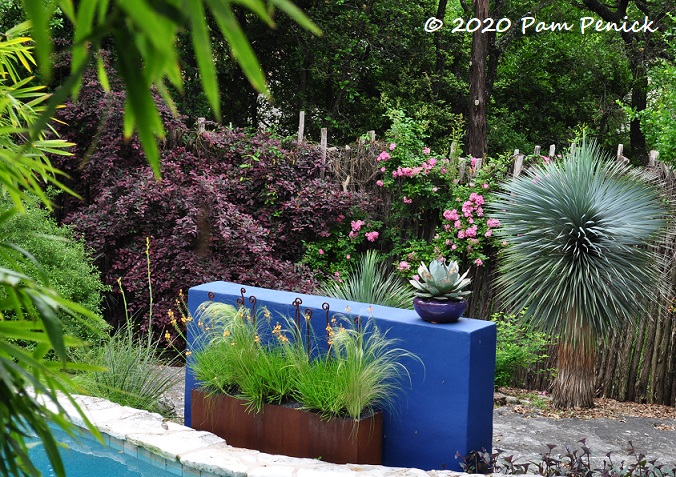
Y’all may get weary of seeing my garden each week while I hole up at home during the pandemic. While I’m missing all the gardens I’m usually able to visit and photograph — and share here at Digging — I am enjoying the time spent in my own garden, especially now that the live oak pollen drop is finally cleaned up. Let’s take a tour around the back garden, shall we?
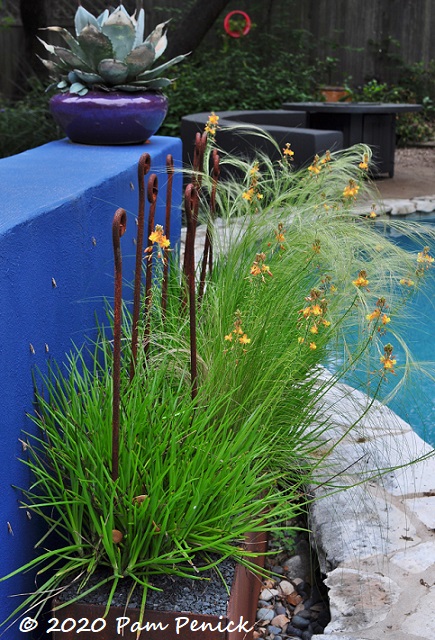
Bulbine and Mexican feathergrass are both abloom in the steel planter by the blue wall.
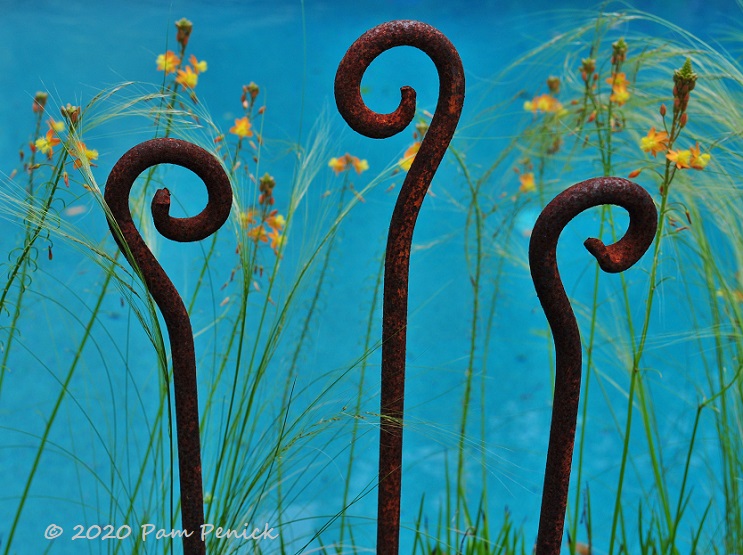
From behind the wall, the swimming pool makes a turquoise backdrop for bulbine and fiddlehead-shaped steel ornaments.
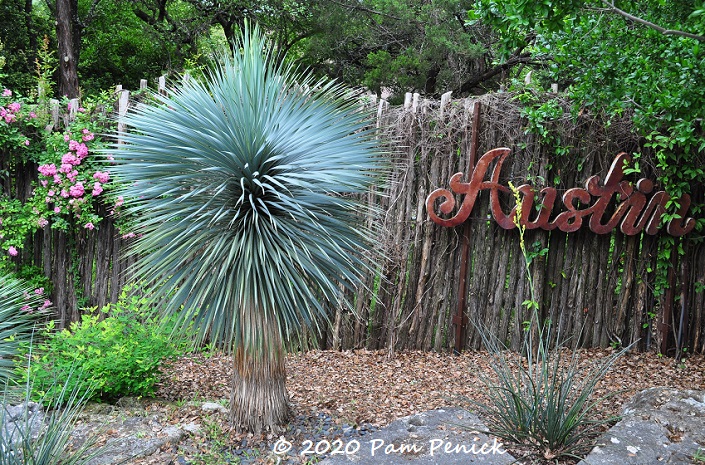
Behind the blue wall stands a Yucca rostrata, my Better Homes and Gardens prize-money plant. Look how big it’s getting!
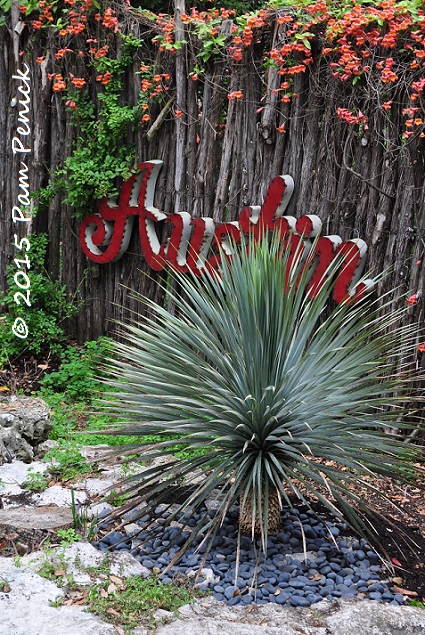
I planted it exactly 5 years ago, pictured here newly installed. It’s grown fast and now stands about 6-1/2 feet tall.
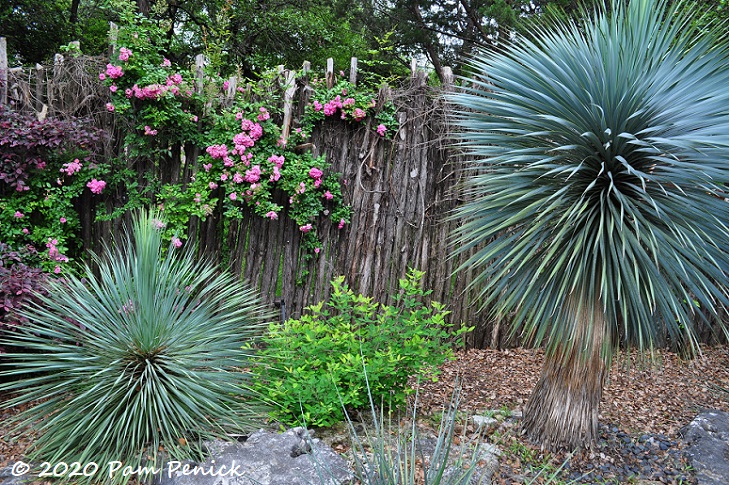
I planted a little brother next to it a couple of years ago. In between is ‘Little Volcano’ bush clover (Lespedeza thunbergii subsp. thunbergii), a fall-blooming exotic I first saw in Ruthie Burrus’s garden. It dies to the ground in winter but has come back the past two springs. The pink rose is ‘Peggy Martin’, which I was inspired to try after seeing a cascade of flowers in my friend Vicki’s garden.
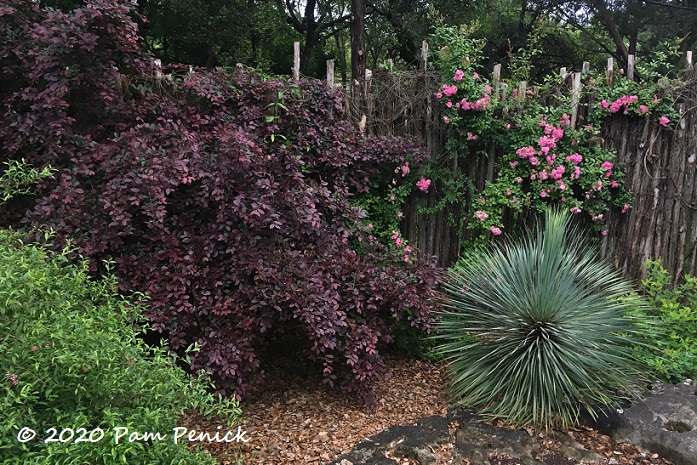
‘Peggy Martin’ looks terrific paired with moody ‘Sizzling Pink’ loropetalum (Loropetalum chinense).

Lounging in his favorite spot — a low wall — Cosmo keeps me company.
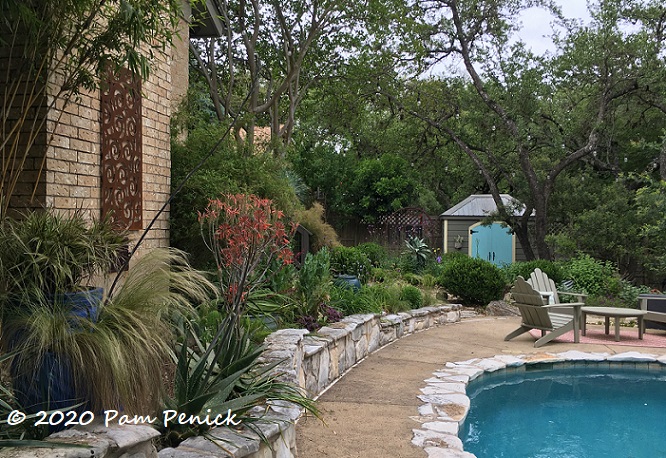
The back garden is shallow but wide, as seen in the long view along the back of the house. A trio of soap aloes (Aloe maculata) in the raised bed have been blooming for weeks. The metal screen on the chimney wall…
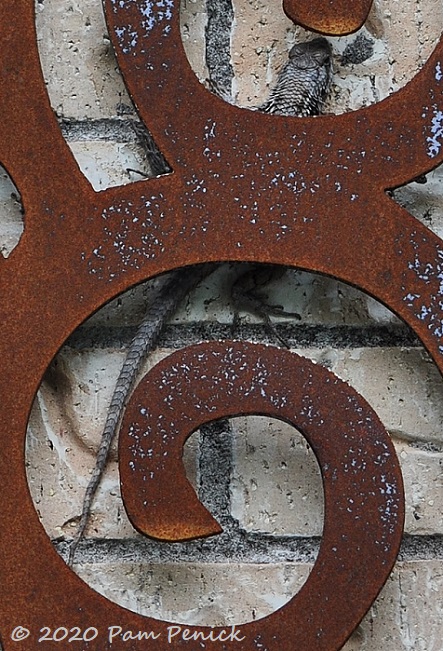
…is a favorite hangout for a big Texas spiny lizard. I see it there nearly every day. Hello, my bug-eating friend!
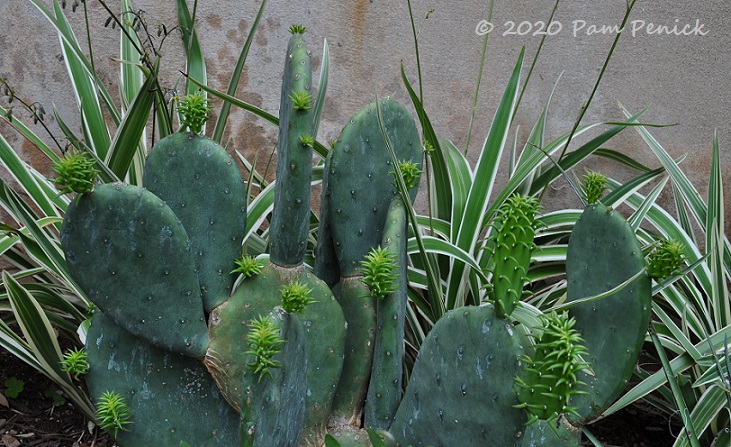
Below the screen grow variegated flax lily (Dianella tasmanica ‘Variegata’) and a native prickly pear, plants that can take the blast furnace of summer in this south-facing, reflected-heat spot.
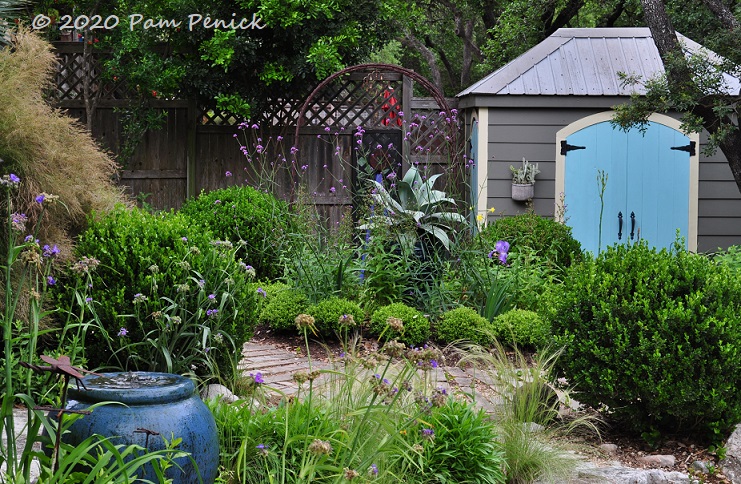
The new Circle Garden, defined by 11-year-old ‘Winter Gem’ boxwood balls and a necklace of new ‘Micron’ holly balls, is viewed through a scrim of Verbena bonariensis.
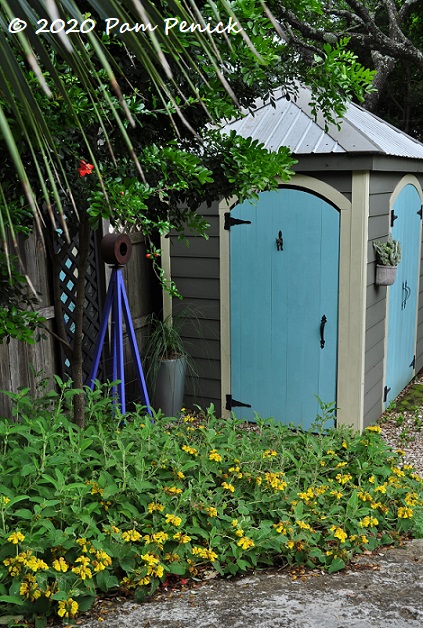
A shade-sprawling Jerusalem sage (Phlomis fruticosa) in golden bloom looks pretty against the turquoise door of the pool-pump shed.
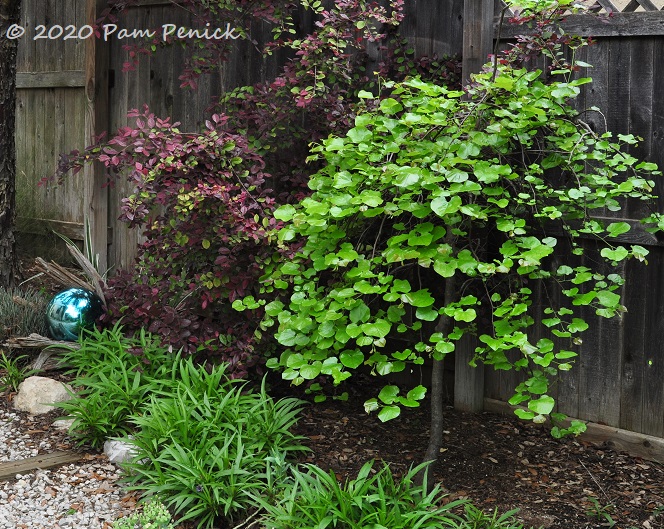
Along the eastside path, ‘Traveller’ weeping redbud (Cercis canadensis var. texensis ‘Traveller’) is clothed in new green leaves that contrast with a ‘Plum’ loropetalum. A fringe of ‘Katie’ dwarf ruellia (Ruellia brittoniana ‘Katie’) will be blooming in a few more weeks.
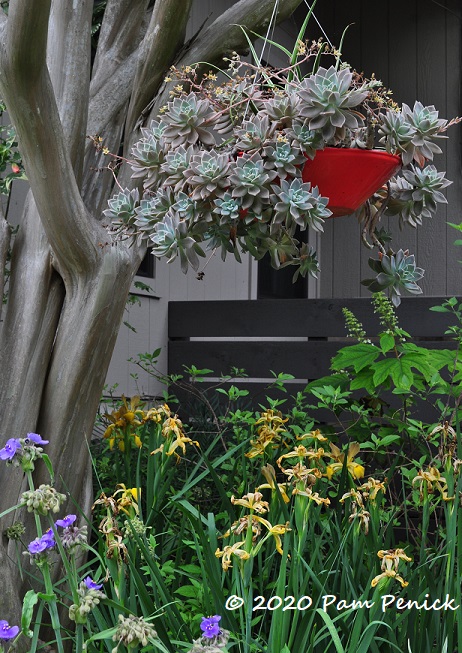
The gold spuria iris are finished, but purple spiderwort (Tradescantia occidentalis) still ekes out a few more blooms each day. Suspended from a crape myrtle, an orange Hover Dish overflows with flowering ghost plant (Graptopetalum paraguayense).
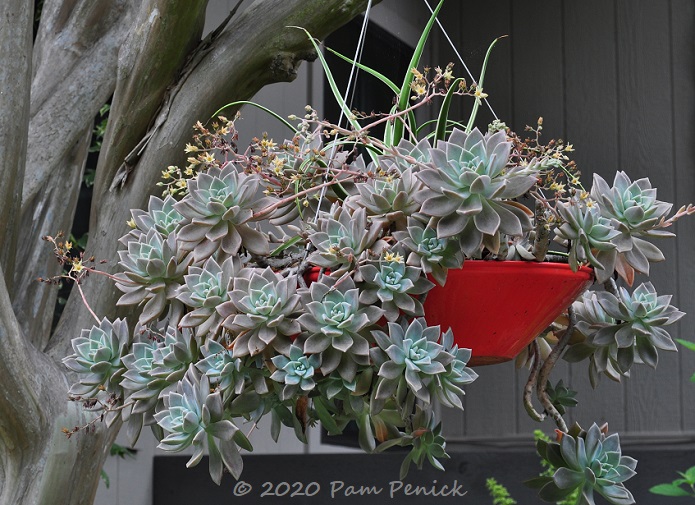
Check out those gorgeous succulent leaves of pinkish gray and pale aqua! I love this hardy (in an Austin winter) succulent. Hummingbirds have been visiting those delicate, straw-colored flowers too.
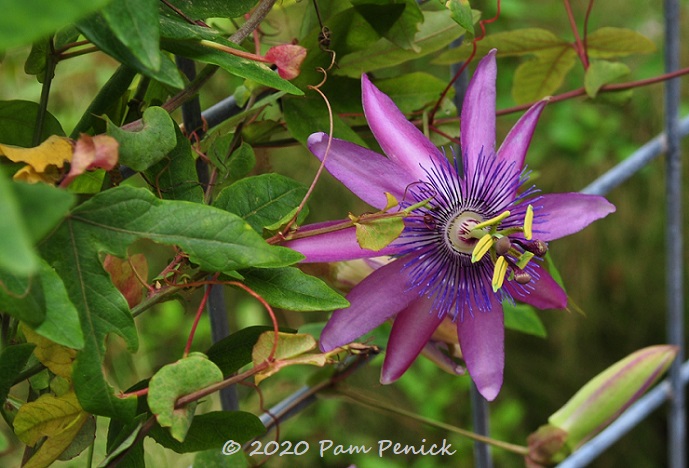
Twining through the deck’s cattle-panel railing, ‘Lavender Lady’ passionflower is putting on a good show too. Gulf fritillary butterflies visit daily, laying eggs on the leaves, so I expect to see hungry orange caterpillars any day now. And that’s OK. They need to eat, and butterflies are a pretty ornament in the garden when flowers are gone.
__________________________
Digging Deeper
Stream Five Seasons: The Gardens of Piet Oudolf, a film about the celebrated plant designer of NYC’s High Line and other gardens, previously watchable only through special screenings, this Friday through Sunday on Hauser & Wirth’s website.
Come learn about gardening and design at Garden Spark! I organize in-person talks by inspiring designers, landscape architects, authors, and gardeners a few times a year in Austin. These are limited-attendance events that sell out quickly, so join the Garden Spark email list to be notified in advance; simply click this link and ask to be added. Season 8 kicks off in fall 2024. Stay tuned for more info!
All material © 2025 by Pam Penick for Digging. Unauthorized reproduction prohibited.


Wondering about your Flax Lily, is that in full sun? I thought it was a shade lover and mine is barely sprouting new leaves here in North Central TX, it is getting morning sun only.
Love the tour!!
It’s in mostly sun — and it’s super hot and reflective right there against the house. So far so good, although I’ve only had dianella in this spot since last fall. I’ve found it pretty adaptable. But if it suffers this summer, I’ll be sure to say so on my blog. So stay tuned! 🙂
If yours is getting a slow start, I doubt it needs more sun if it’s getting morning sun. It may just need heat. It’s a heat lover. In fact, I can’t help wondering if it survives a North Texas winter. It sometimes gets whacked hard by Austin’s occasional winter freezes.
Dear Pam,
I keep meaning to write and tell you how much I enjoy your Digging blog. I was inspired to write today, because yesterday at the HEB checkout line I picked up a copy of BH&G Succulents 2020 and came across your Creative Containers article. Very nice! And in this blog post I see your exuberant hanging basket of Graptopetalum–lovely.
Although I don’t comment often, I do follow your posts and always look forward to finding them in my in-box.
Best wishes,
Debra
Oh what a lovely comment, Debra! It made my day! Thank you for being a loyal reader. 🙂 And thanks too for letting me know about the BH&G Succulents article. I don’t know if I’m going to find a copy during this self-quarantine. Would it be too much of an imposition for me to ask if you could send me a scan or a cell phone photo of the article? I’d love to have a look! I’ll email you my email address. Thanks again!
Thanks again Pam for your inspirational photos. I’d love to try that Ghost Plant (succulent) in
my Bedford Texas garden. Stay Safe.
Thanks for your comment, Nicola! You should definitely give it a try. I’m not sure how far north it winters over, but it’s easy to bring inside a little pot of succulents during a hard freeze.
With temps today in Austin in the high 90s (15 degrees higher than normal and a record breaker) that pool is looking mighty refreshing! Hope you get to take a dip. And Cosmo–where did he learn to pose like that? So cute.
It’s fun to look back at pictures taken 5 yrs ago of plantings and see how things have changed. Recently came across pics we took when we finally planted the Meyer’s lemon tree out into the yard. Had kept it in a pot in case I needed to protect it in winter, but my husband really wanted it in the yard. It has mushroomed into a lush, dwarf tree–only about 4 ft tall, which is good picking height. And this past winter, it had a bumper crop of 102 large lemons (typically less than 40)! Having the pictures to look back at provides the visual reinforcement that “it” is actually going better than I thought it was. I have come to learn to embrace what John Hart Asher says at the close of Central Texas Gardener “Adopt the pace of nature. Her secret is patience.” I didn’t realize that was a Ralph Waldo Emerson quote–seems timely as ever!
Thanks again for a lovely, inspiring, informational blog!
102 lemons, wow! And you’re so right that photos give you the chance to see how much progress you’ve made or just how big your plants have grown. It’s easy to forget where you started from. I love that Emerson quote — so true. Thanks for sharing, Beverly!
Since we have to hole up this is a good time of year to have to do it. So much going on in the home garden that is isn’t a real drag. Your garden looks splendid. Your dish doth runneth over.
Thanks, Lisa. I do feel very fortunate to have my garden to keep me busy and sane during this anxious time.
It’s great to see more of your beautiful garden, Pam! I love that first shot, and all your photos of the Yucca rostrata. The few I’ve come across locally cost an arm and a leg but last year I purchased one from Annie’s mail order nursery at a very reasonable price – except it was in a 4-inch pots as all Annie’s plants are. So it’s going to be a LONG time before it looks anything like yours. It’s good to see Cosmo too!
A 4-inch Yucca rostrata! I don’t know if I’ve ever seen one that small. Here they are commonly sold, and quite affordable, in 1- and 3-gallon sizes. I believe the first one I planted, close to the old stock-tank pond, was a 3-gallon that cost about $25, although that was about 11 years ago. Once they develop a trunk, they get pretty expensive though. Happily, they grow quickly here, given plenty of sunshine and occasional irrigation (with excellent drainage, of course). I hope your little baby will prove a fast grower too.
More beautiful photos, inspiring as always! I love your fiddlehead art, and it warms my heart to see the photo of Cosmo. Dogs can be such great gardening buddies.
They sure can. Thanks for your comment, Maggie!
Oh that Hover Dish / Graptopetalum paraguayense combo is fabulous!
It’s really come into its own over the past two years. It was there at Austin Fling, but the plants were just babies then.
Your yard looks wonderful, I never tire of photos in your garden, your mix of close ups and wider shots are perfect, and we all enjoy shots of Cosmo, lizards, bees, etc. Your dish of graptopetalum is such a head turner, how often do you water that? I have some in pots for quite awhile that are surviving but not flourishing like yours, maybe I’m watering too much!
Thanks for the lovely compliment, Heidi! It is definitely easy to overwater succulents. I probably water this dish maybe twice a month in summer. If you’re in a hot climate like me, it’s also imperative to give them some shade. Morning sun or all-day dappled shade works best, I find.